Dynamic Properties and Energy Dissipation Study of Sandwich Viscoelastic Damper Considering Temperature Influence
Abstract
:1. Introduction
2. Performance Tests
2.1. Test Process
2.2. Test Esults
3. Mathematical Modeling
4. Self-Generated Heating of the Sandwich Viscoelastic Damper
5. Conclusions
Author Contributions
Funding
Institutional Review Board Statement
Informed Consent Statement
Data Availability Statement
Acknowledgments
Conflicts of Interest
References
- Xu, Z.D.; Huang, X.H.; Xu, F.H.; Yuan, J. Parameters optimization of vibration isolation and mitigation system for precision platforms using non-dominated sorting genetic algorithm. Mech. Syst. Signal Process. 2019, 128, 191–201. [Google Scholar] [CrossRef]
- Lu, Z.; Wang, Z.X.; Zhou, Y.; Lu, X.L. Nonlinear dissipative devices in structural vibration control: A review. J. Sound Vib. 2018, 423, 18–49. [Google Scholar] [CrossRef]
- Rao, M.D. Recent applications of viscoelastic damping for noise control in automobiles and commercial airplanes. J. Sound Vib. 2003, 262, 457–474. [Google Scholar] [CrossRef]
- Xu, Z.D.; Xu, Y.S.; Yan, Q.Q.; Xu, C.; Xu, F.H.; Wang, C. Tests and modeling of a new vibration isolation and suppression device. J. Dyn. Syst. Meas. Control 2017, 139, 121011. [Google Scholar] [CrossRef]
- Mori, K.; Kono, D.; Yamaji, I.; Matsubara, A. Vibration reduction of machine tool using viscoelastic damper support. Procedia CIRP 2016, 46, 448–451. [Google Scholar] [CrossRef] [Green Version]
- Dai, J.; Xu, Z.D.; Gai, P.P.; Hu, Z.W. Optimal design of tuned mass damper inerter with a Maxwell element for mitigating the vortex-induced vibration in bridges. Mech. Syst. Signal Process. 2021, 148, 107180. [Google Scholar] [CrossRef]
- Nielsen, E.J.; Lai, M.L.; Soong, T.T.; Kelly, J.M. Viscoelastic damper overview for seismic and wind applications. Proc. SPIE Smart Mater. Struct. 1996, 2720, 138–144. [Google Scholar] [CrossRef]
- Tsai, C.S.; Lee, H.H. Applications of viscoelastic dampers to high-rise buildings. J. Struct. Eng.-ASCE 1993, 120, 1222–1233. [Google Scholar] [CrossRef]
- Xu, Z.D. Earthquake mitigation study on viscoelastic dampers for reinforced concrete structures. J. Vib. Control 2007, 13, 29–45. [Google Scholar] [CrossRef]
- Pant, D.R.; Montgomery, M.; Christopoulos, C. Full-scale testing of a viscoelastic coupling damper for high-rise building applications and comparative evaluation of different numerical models. J. Struct. Eng.-ASCE 2018, 145, 04018242. [Google Scholar] [CrossRef] [Green Version]
- Xu, Z.D.; Liao, Y.X.; Ge, T.; Xu, C. Experimental and theoretical study on viscoelastic dampers with different matrix rubbers. J. Eng. Mech. ASCE 2016, 142, 04016051. [Google Scholar] [CrossRef]
- Asano, M.; Masahiko, H.; Yamamoto, M. The experimental study on viscoelastic material dampers and the formulation of analytical model. In Proceedings of the 12th World Conference on Earthquake Engineering, Auckland, New Zealand, 30 January–4 February 2000; p. 1535. [Google Scholar]
- Shen, K.L.; Soong, T.T. Modeling of viscoelastic dampers for structural applications. J. Eng. Mech.-ASCE 1995, 121, 694–701. [Google Scholar] [CrossRef]
- Mazza, F.; Fiore, M.; Mazza, M. Dynamic response of steel framed structures fire-retrofitted with viscoelastic-damped braces. Int. J. Civ. Eng. 2017, 15, 1187–1201. [Google Scholar] [CrossRef]
- Christopoulos, C.; Montgomery, M. Viscoelastic coupling dampers for enhanced multiple seismic hazard level performance of high-Rise buildings. Earthq. Spectra 2018, 34, 1847–1867. [Google Scholar] [CrossRef]
- Xu, Z.D.; Shen, Y.P.; Zhao, H.T. A synthetic optimization analysis method on structures with viscoelastic dampers. Soil Dyn. Earthq. Eng. 2003, 23, 683–689. [Google Scholar] [CrossRef]
- Xu, Z.D.; Zhao, H.T.; Li, A.Q. Optimal analysis and experimental study on structures with viscoelastic dampers. J. Sound Vib. 2004, 273, 607–618. [Google Scholar] [CrossRef]
- Lakes, R. Viscoelastic Materials; Cambridge University Press: New York, NY, USA, 2009. [Google Scholar]
- Park, S.W. Analytical modeling of viscoelastic dampers for structural and vibration control. Int. J. Solids St. 2001, 38, 8065–8092. [Google Scholar] [CrossRef]
- Xu, Y.S.; Xu, Z.D.; Guo, Y.Q.; Ge, T.; Xu, C.; Huang, X.H. Theoretical and experimental study of viscoelastic damper based on fractional derivative approach and micromolecular structures. J. Vib. Acoust. 2019, 141, 031010. [Google Scholar] [CrossRef]
- Bagley, R.L.; Torvik, P.J. Fractional calculus in the transient analysis of viscoelastically damped structures. AIAA J. 1985, 23, 918–925. [Google Scholar] [CrossRef]
- Meral, F.C.; Royston, T.J.; Magin, R. Fractional calculus in viscoelasticity: An experimental study. Commun. Nonlinear Sci. 2010, 15, 939–945. [Google Scholar] [CrossRef]
- Gandhi, F.; Chopra, I. A time-domain non-linear viscoelastic damper model. Smart Mater. Struct. 1996, 5, 517–528. [Google Scholar] [CrossRef]
- Lewandowski, R. Influence of temperature on the dynamic characteristics of structures with viscoelastic dampers. J. Struct. Eng. 2018, 145, 04018245. [Google Scholar] [CrossRef]
- Xu, Z.D.; Xu, C.; Hu, J. Equivalent fractional Kelvin model and experimental study on viscoelastic damper. J. Vib. Control 2015, 21, 2536–2552. [Google Scholar] [CrossRef]
- Cazenove, J.; Rade, D.A.; Lima, A.M.G.D.; Pagnacco, E. A numerical and experimental investigation on self-heating effects in viscoelastic dampers. Mech. Syst. Signal Process. 2012, 27, 433–445. [Google Scholar] [CrossRef]
- Gopalakrishna, H.S.; Lai, M.L. Finite element heat transfer analysis of viscoelastic damper for wind applications. J. Wind. Eng. Ind. Aerodyn. 1998, 77, 283–295. [Google Scholar] [CrossRef]
- Lesieutre, G.A.; Govindswamy, K.M. Finite element modeling of frequency-dependent dynamic behavior of viscoelastic materials in simple shear. Int. J. Solids Struct. 1995, 33, 419–432. [Google Scholar] [CrossRef]
- Schapery, R.A. Effect of cyclic loading on the temperature in viscoelastic media with variable properties. AIAA J. 1964, 2, 827–835. [Google Scholar] [CrossRef]
- Bérardi, G.; Jaeger, M.; Martin, R.; Carpentier, C. Modelling of a thermo-viscoelastic coupling for large deformations through finite element analysis. Int. J. Mass Heat Transf. 1996, 39, 3911–3924. [Google Scholar] [CrossRef]
- Drozdov, A.D.; Dorfmann, A. The effect of temperature on the viscoelastic response of rubbery polymers at finite strains. Acta. Mech. 2002, 154, 189–214. [Google Scholar] [CrossRef] [Green Version]
- Inaudi, J.A.; Blondet, M.; Kelly, J.M.; Aprile, A. Heat generation effects on viscoelastic dampers in structures. In Proceedings of the 11th World Conference on Earthquake Engineering, Pergamon Elsevier Science, Oxford, UK, 23–28 June; 28 June 1996; p. 424. [Google Scholar]
- Rodas, C.O.; Zaïri, F.; Naït-Abdelaziz, M. A finite strain thermo-viscoelastic constitutive model to describe the self-heating in elastomeric materials during low-cycle fatigue. J. Mech. Phys. Solids 2014, 64, 396–410. [Google Scholar] [CrossRef]
- Xu, Z.D.; Wang, D.X.; Shi, C.F. Model, tests and application design for viscoelastic dampers. J. Vib. Control 2011, 17, 1359–1370. [Google Scholar] [CrossRef]
- Deng, Y.J.; Yi, P.Y.; Peng, L.F.; Lai, X.M.; Lin, Z.Q. Flow behavior of polymers during the roll-to-roll hot embossing process. J. Micromech. Microeng. 2015, 25, 065004. [Google Scholar] [CrossRef]
- Mansour, S.A.; Al-Ghoury, M.E.; Shalaan, E.; El-Eraki, M.H.I.; Abdel-Bary, E.M. Thermal properties of graphite-loaded nitrile rubber/poly (vinyl chloride) blends. J. Appl. Polym. Sci. 2010, 116, 3171–3177. [Google Scholar] [CrossRef]
- Youssef, H.M.; El-Bary, A.A. Thermal shock problem of a generalized thermoelastic layered composite material with variable thermal conductivity. Math. Probl. Eng. 2006, 2006, 087940. [Google Scholar] [CrossRef] [Green Version]
- Younis, L.B.; Viskanta, R. Experimental determination of the volumetric heat transfer coefficient between stream of air and ceramic foam. Int. J. Heat Mass. Transf. 1993, 36, 1425–1434. [Google Scholar] [CrossRef]

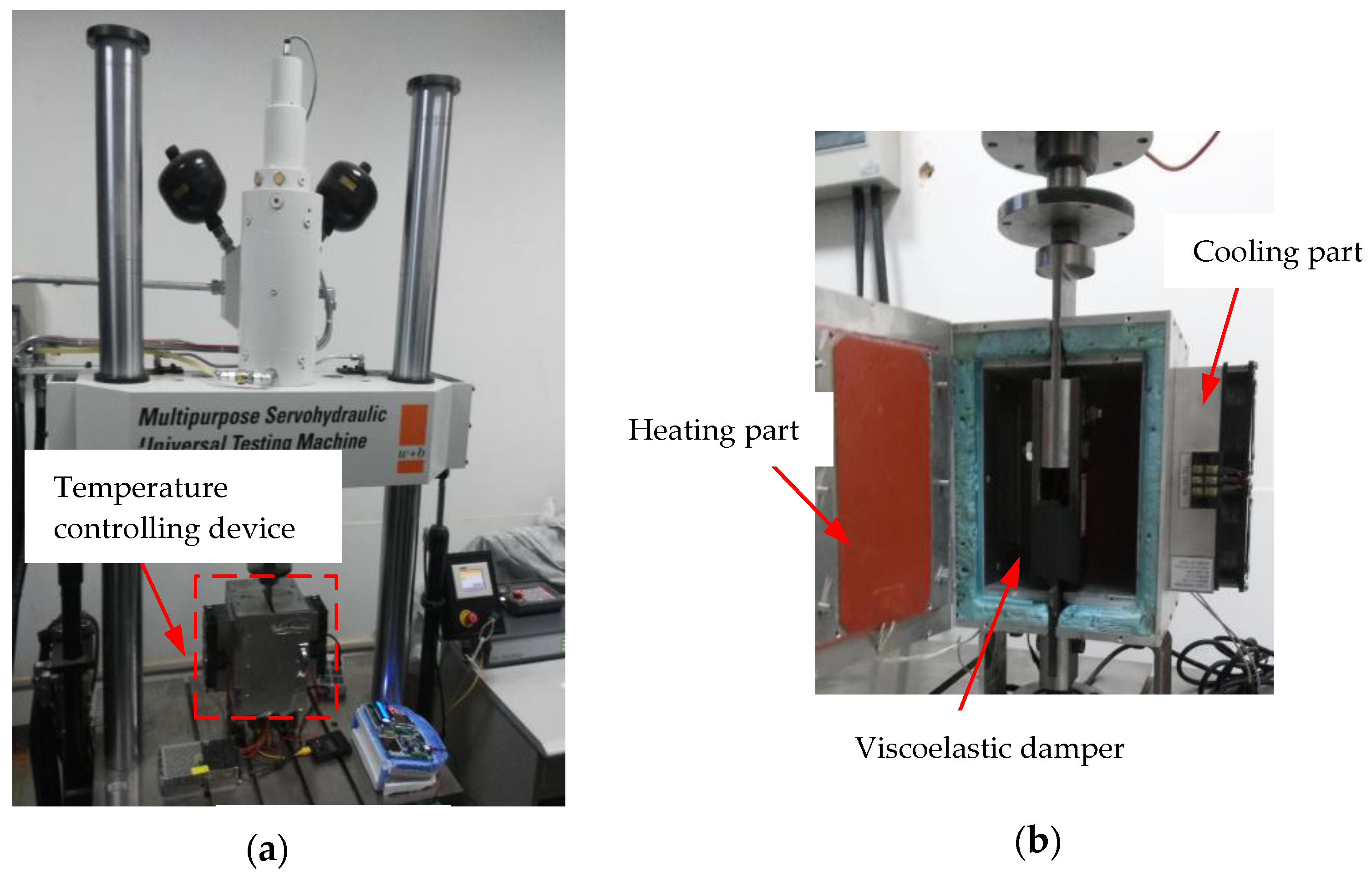
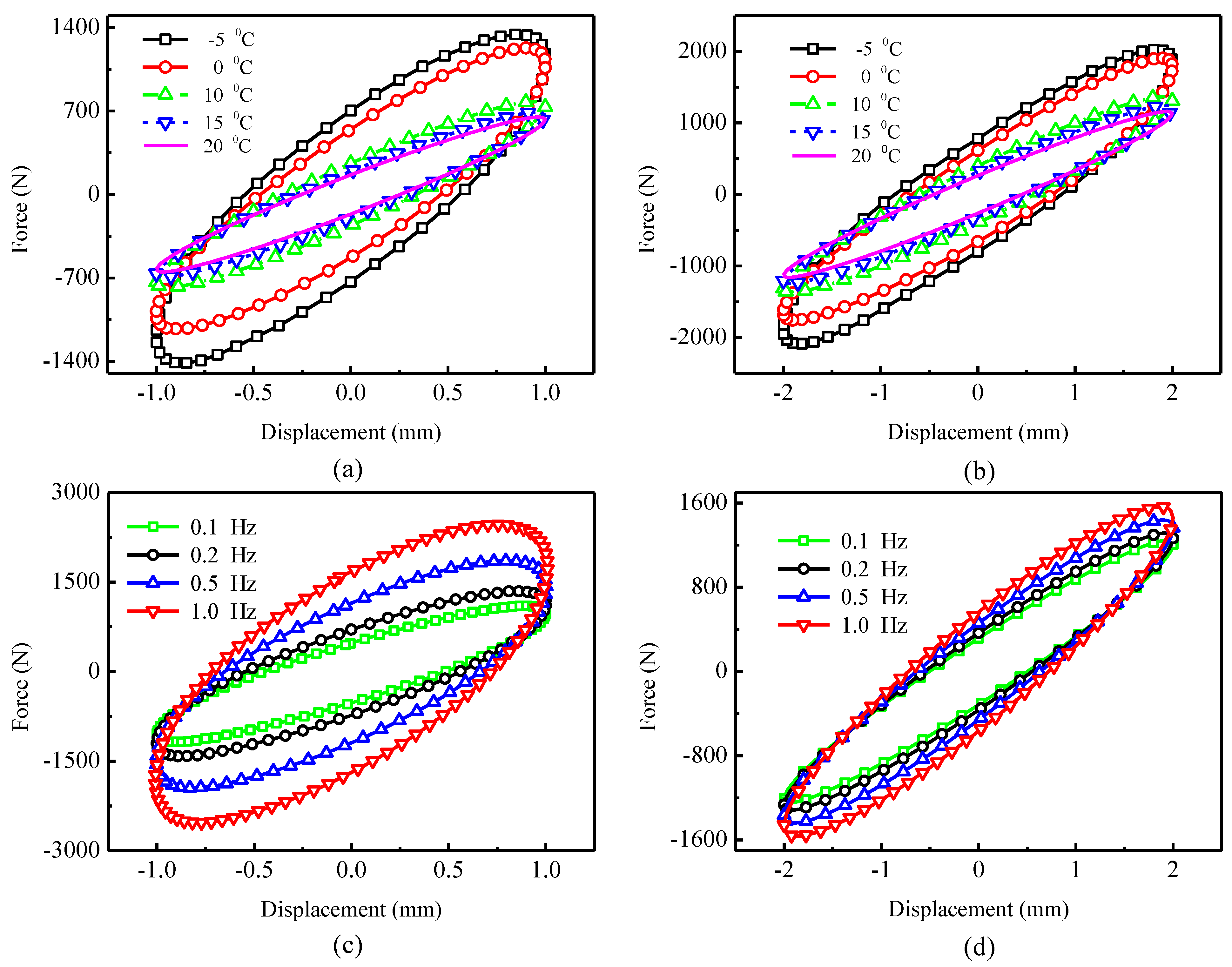
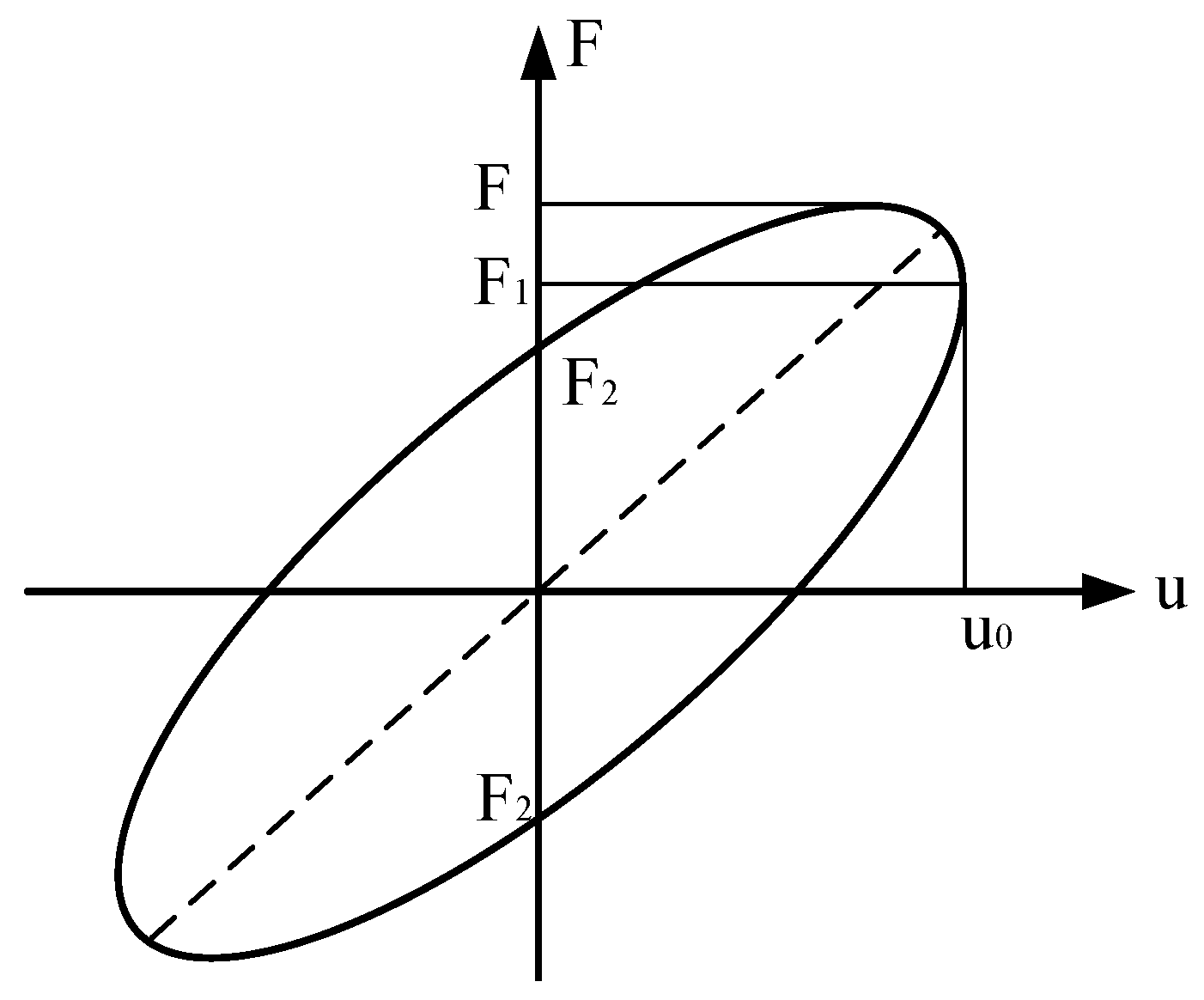
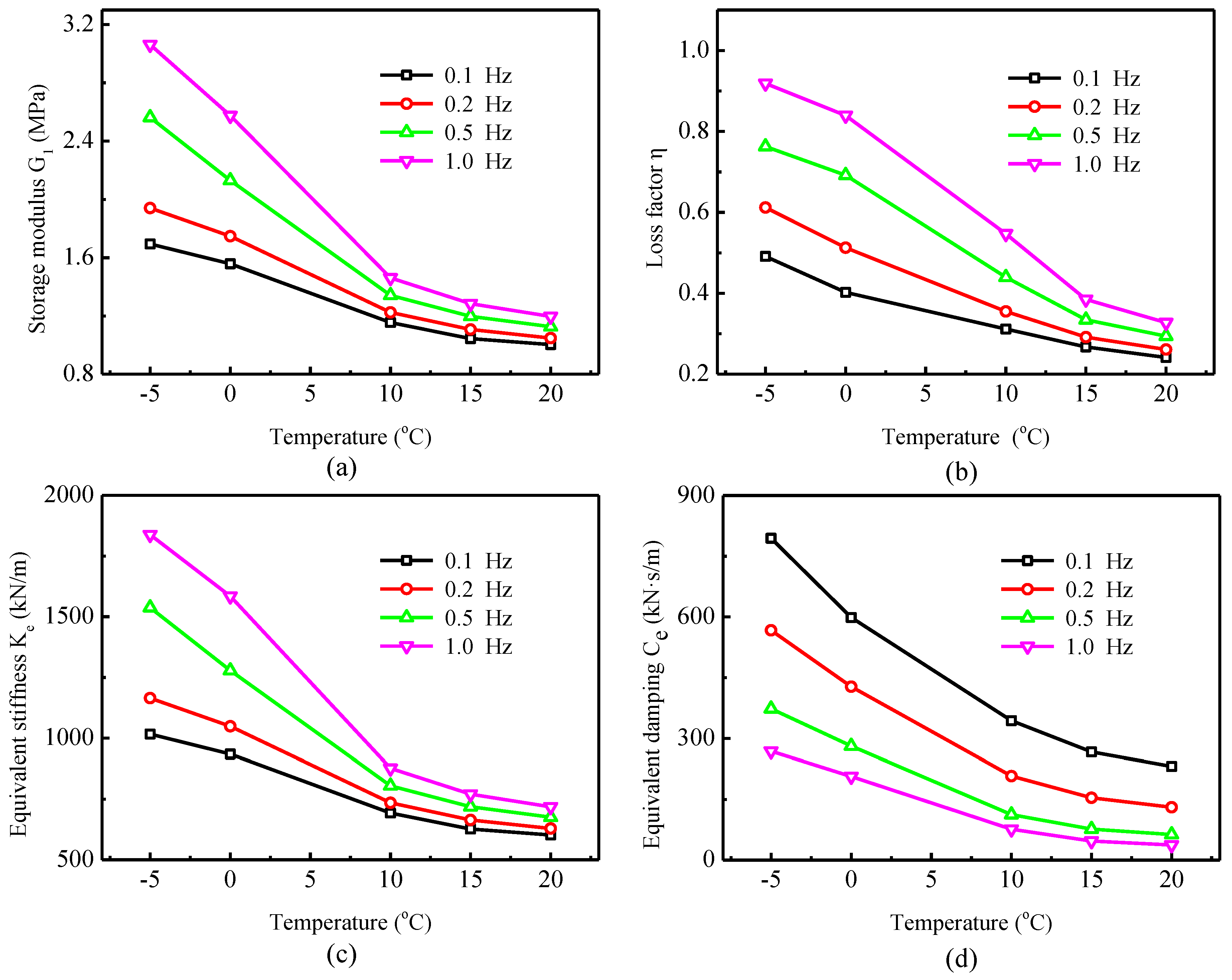
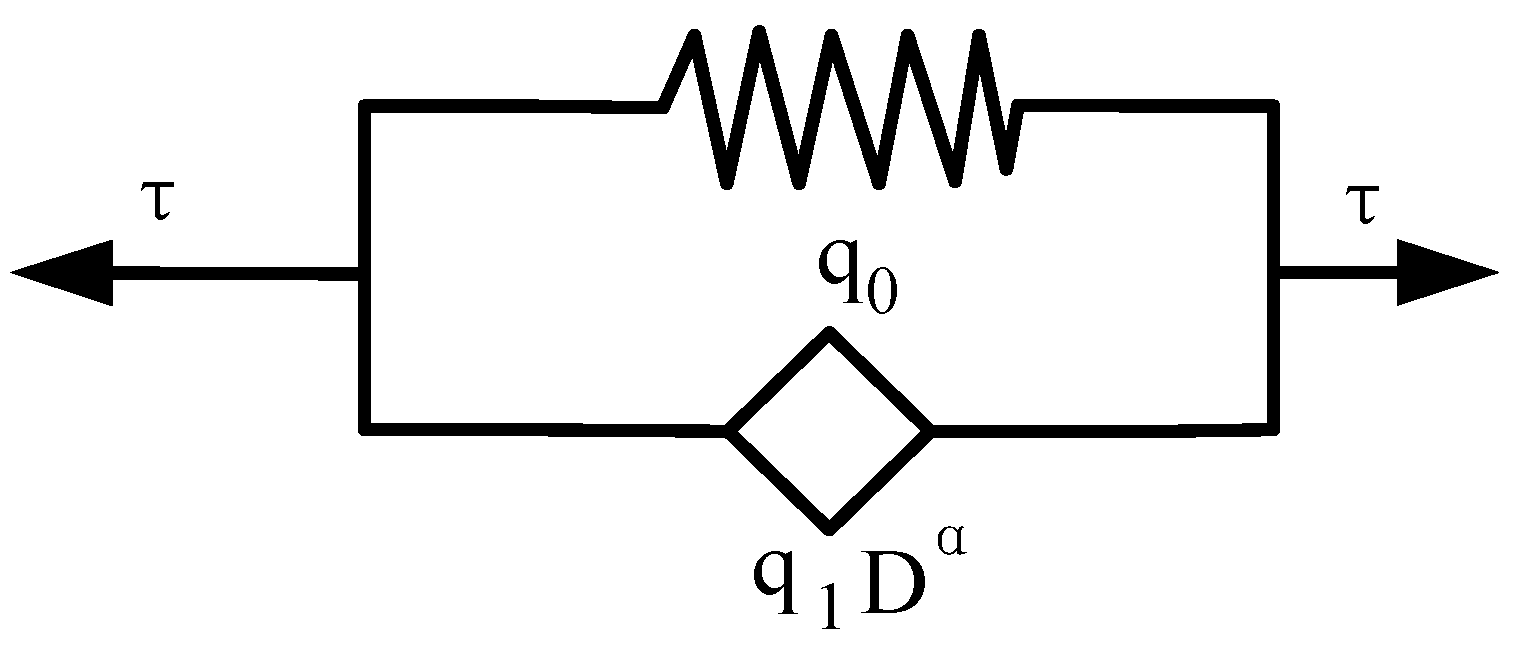

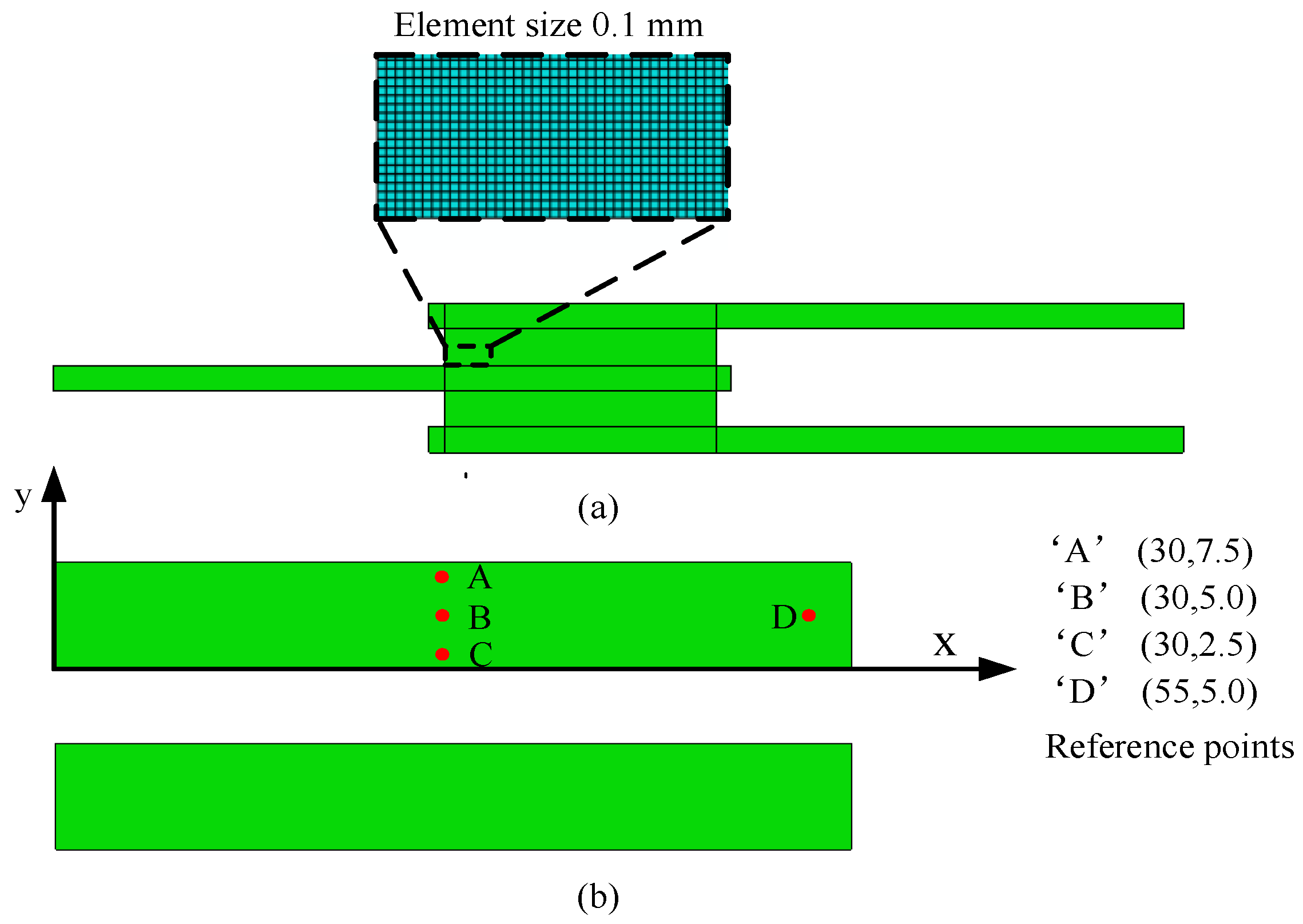
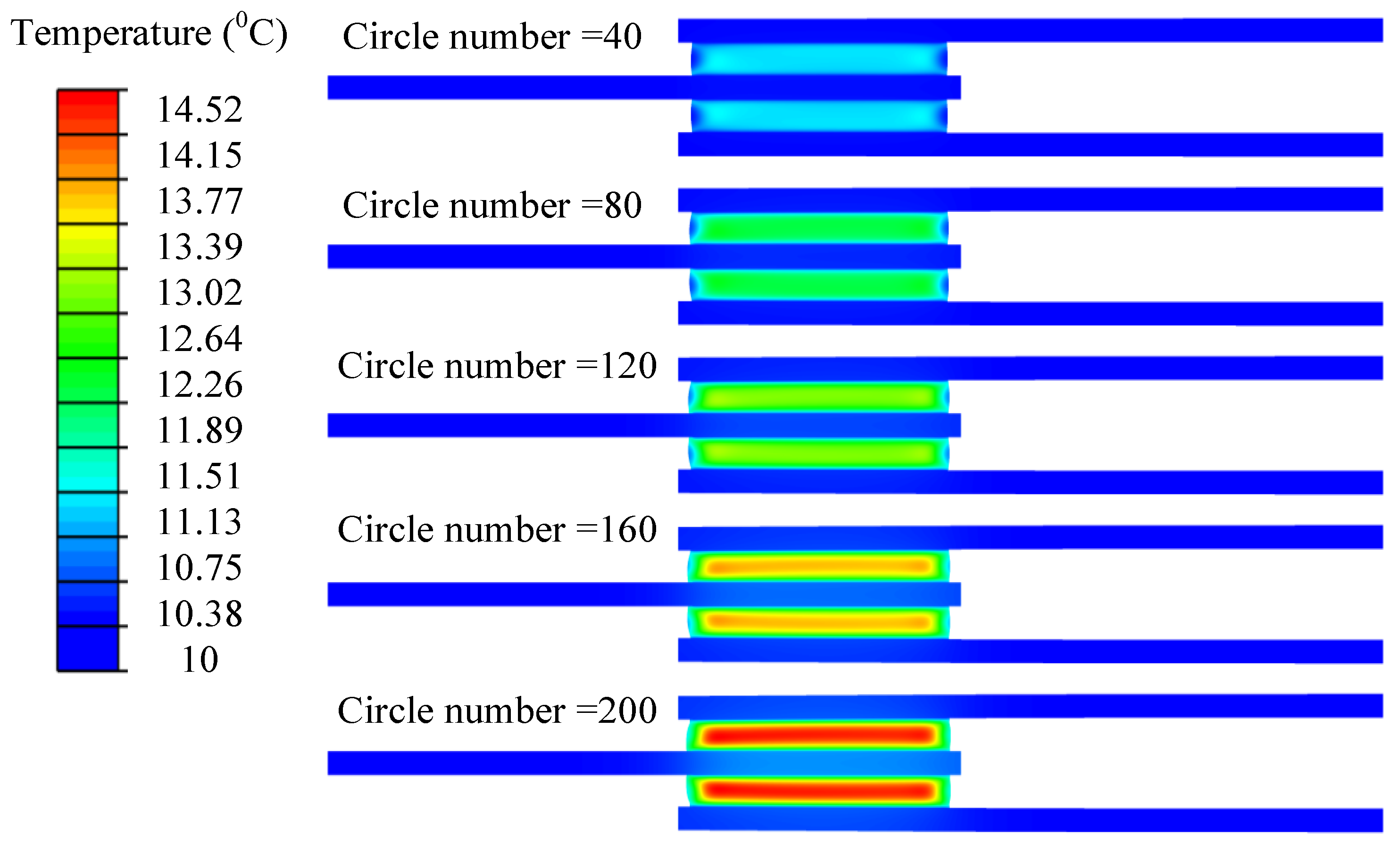

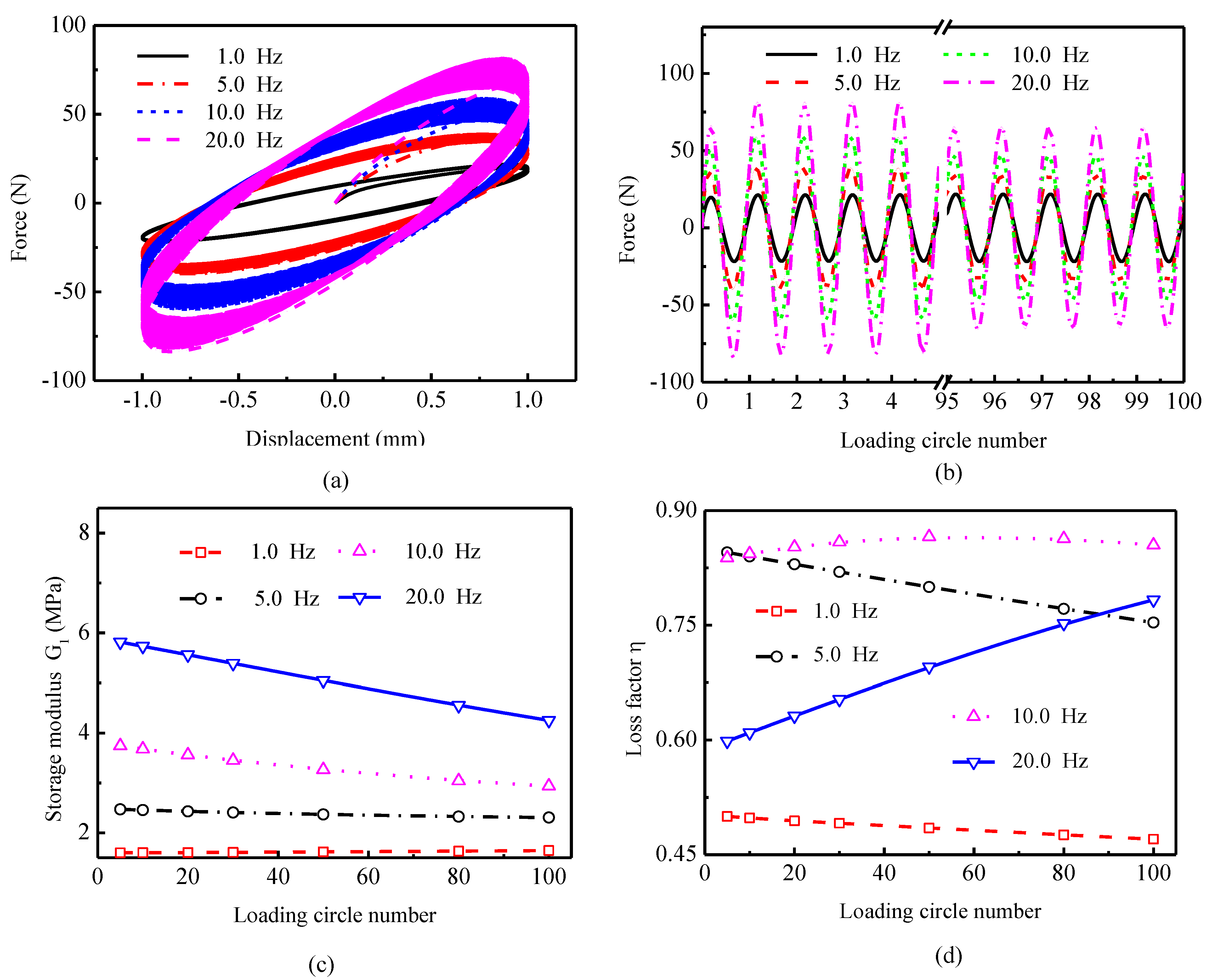
| Temperature (°C) | Displacement Amplitude d (mm) | Frequency f (Hz) | Cyclic Number |
|---|---|---|---|
| −5, 0, 10, 15, 20 | 1.0, 2.0 | 0.1, 0.2, 0.5, 1.0 | 5 |
| Temperature (°C) | Frequency | Storage Modulus | Loss Factor | ||
|---|---|---|---|---|---|
| −5 | 0.1 | 1.69 | 0.49 | 1016.57 | 794.49 |
| 0.2 | 1.94 | 0.61 | 1164.49 | 566.99 | |
| 0.5 | 2.56 | 0.76 | 1537.5 | 373.22 | |
| 1.0 | 3.06 | 0.92 | 1837.54 | 268.65 | |
| 0 | 0.1 | 1.56 | 0.4 | 934.58 | 598.56 |
| 0.2 | 1.75 | 0.51 | 1048.61 | 427.84 | |
| 0.5 | 2.13 | 0.69 | 1278.11 | 281.38 | |
| 1.0 | 2.64 | 0.82 | 1584.48 | 206.41 | |
| 10 | 0.1 | 1.15 | 0.31 | 692.89 | 343.78 |
| 0.2 | 1.22 | 0.36 | 734.79 | 207.68 | |
| 0.5 | 1.34 | 0.44 | 804.67 | 112.59 | |
| 1.0 | 1.46 | 0.55 | 876.86 | 76.31 | |
| 15 | 0.1 | 1.04 | 0.27 | 626.66 | 266.7 |
| 0.2 | 1.11 | 0.29 | 664.27 | 154.16 | |
| 0.5 | 1.2 | 0.33 | 718.45 | 76.54 | |
| 1.0 | 1.28 | 0.38 | 770.4 | 47.19 | |
| 20 | 0.1 | 1.0 | 0.24 | 602.2 | 231.29 |
| 0.2 | 1.05 | 0.26 | 628.87 | 130.71 | |
| 0.5 | 1.13 | 0.29 | 675.75 | 63.24 | |
| 1.0 | 1.2 | 0.33 | 718.02 | 37.42 |
| Temperature (°C) | Frequency | Experimental Results | Numerical Results | ||
|---|---|---|---|---|---|
| Storage Modulus | Loss Factor | Storage Modulus | Loss Factor | ||
| −5 | 0.1 | 1.55 | 0.43 | 1.48 | 0.47 |
| 0.2 | 1.77 | 0.54 | 1.78 | 0.53 | |
| 0.5 | 2.13 | 0.68 | 2.35 | 0.60 | |
| 1.0 | 2.45 | 0.77 | 2.96 | 0.64 | |
| 0 | 0.1 | 1.43 | 0.37 | 1.25 | 0.41 |
| 0.2 | 1.58 | 0.47 | 1.47 | 0.47 | |
| 0.5 | 1.88 | 0.63 | 1.88 | 0.54 | |
| 1.0 | 2.2 | 0.75 | 2.33 | 0.60 | |
| 10 | 0.1 | 1.09 | 0.30 | 0.96 | 0.29 |
| 0.2 | 1.15 | 0.35 | 1.08 | 0.35 | |
| 0.5 | 1.27 | 0.42 | 1.31 | 0.43 | |
| 1.0 | 1.36 | 0.53 | 1.56 | 0.49 | |
| 15 | 0.1 | 1.0 | 0.26 | 0.88 | 0.24 |
| 0.2 | 1.05 | 0.29 | 0.97 | 0.29 | |
| 0.5 | 1.14 | 0.34 | 1.14 | 0.37 | |
| 1.0 | 1.22 | 0.39 | 1.32 | 0.43 | |
| 20 | 0.1 | 0.94 | 0.23 | 0.82 | 0.19 |
| 0.2 | 0.98 | 0.26 | 0.88 | 0.24 | |
| 0.5 | 1.05 | 0.29 | 1.01 | 0.32 | |
| 1.0 | 1.11 | 0.31 | 1.15 | 0.38 | |
| 13.104 | 486.9721 | 0.3485 | 0.0357 | 0.0546 | 0.502 |
| 12 | 525 |
| Material | Specific Heat | |||
|---|---|---|---|---|
| Viscoelastic material | 0.16 | 990 | 2000 | |
| Steel plate | 19.5 | 7970 | 561 |
Publisher’s Note: MDPI stays neutral with regard to jurisdictional claims in published maps and institutional affiliations. |
© 2021 by the authors. Licensee MDPI, Basel, Switzerland. This article is an open access article distributed under the terms and conditions of the Creative Commons Attribution (CC BY) license (https://creativecommons.org/licenses/by/4.0/).
Share and Cite
Xu, Y.; Xu, Z.; Guo, Y.; Huang, X.; Dong, Y.; Li, Q. Dynamic Properties and Energy Dissipation Study of Sandwich Viscoelastic Damper Considering Temperature Influence. Buildings 2021, 11, 470. https://doi.org/10.3390/buildings11100470
Xu Y, Xu Z, Guo Y, Huang X, Dong Y, Li Q. Dynamic Properties and Energy Dissipation Study of Sandwich Viscoelastic Damper Considering Temperature Influence. Buildings. 2021; 11(10):470. https://doi.org/10.3390/buildings11100470
Chicago/Turabian StyleXu, Yeshou, Zhaodong Xu, Yingqing Guo, Xinghuai Huang, Yaorong Dong, and Qiangqiang Li. 2021. "Dynamic Properties and Energy Dissipation Study of Sandwich Viscoelastic Damper Considering Temperature Influence" Buildings 11, no. 10: 470. https://doi.org/10.3390/buildings11100470








